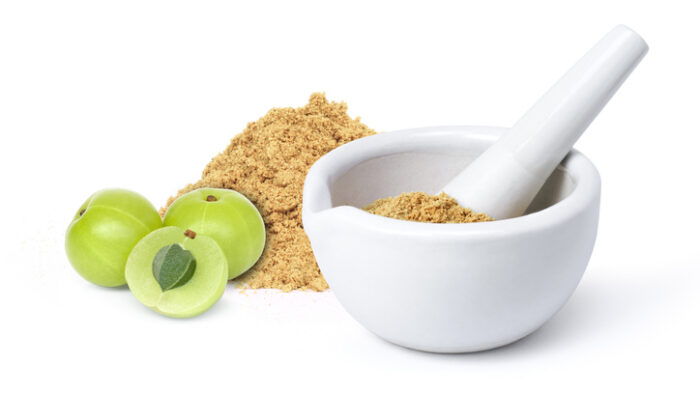Known in Hindi as amla - the term for sour - amalaki is a living symbol for everything related to sour and its powerful effect on the body. Called the Indian gooseberry in English or the emblic myrobalan in botanical parlance, its taxonomical name is now Emblica officinalis, derived from the Sanskrit term amlika, meaning sour; and officinalis, the Latin term for a workshop-laboratory whose items are of use, especially medicinally to man.
 Amalaki, known as amla, avra and nelli, also has a multitude of both regional language names and variety names. Amalaki rose to fame outside India due to a solitary study that verified high vitamin C content, showing it contained 479 mg of Vitamin C in 100mL of juice or 750-850 mg of Vitamin C in 100 gram of fruit pulp, compared to other common fruits apple, lime, pomegranate, and two types of grape (ref PFHN, 2004, Jain, Khurdiya).
Amalaki, known as amla, avra and nelli, also has a multitude of both regional language names and variety names. Amalaki rose to fame outside India due to a solitary study that verified high vitamin C content, showing it contained 479 mg of Vitamin C in 100mL of juice or 750-850 mg of Vitamin C in 100 gram of fruit pulp, compared to other common fruits apple, lime, pomegranate, and two types of grape (ref PFHN, 2004, Jain, Khurdiya).
The ancients of Bharat however knew the marvels of this little round hard lime green-yellow fruit. Through thousands of years of history, Sanskrit captured its value with many names, among them dhatrika, shriphala, amruta, sheeta, rochani, vrushya, gayatrei, tishyaphala, pancharasa, and kayastha. Its synonym dhatri comes from the Sanskrit term for the earth, and with dhatrika as the feminine form, with the connotation of mother or the act of nursing. In mythology, Dhatri is the god of health and domestic tranquility. Dhatri also refers to the nourishing and protection that the planet gives to us who live on it. It points to the deeper wisdom that this fruit can nurture our gut and help us grow.
Amalaki is also known as Shriphala, the fruit of Shri, the symbol of auspicious prosperity, good fortune and abundance. Keeping people healthy and strong, it allows them to work and live long, so that they can create and enjoy the wealth that good health brings. Amalaki is known as Amruta, because it preserves life and is thus like ambrosia. Called Sheeta, its veerya (potency) is cooling, so it cools the body’s pitta.
Its name Gayatrei refers to mother earth and her abundance and balancing power. Vrushya comes from the Sanskrit term Vrsya, which refers to the healthy spread of seed for growth and sustenance. Rochani refers to its use in healing wounds. Tishyaphala is the fruit (phala) of tishya, which means both auspicious-fortunate, is also another term for the month of Pausha, which falls during December/January. This is the best month to harvest the ripe fruit for medicinal formulations. Charaka also calls amalaki with the name pancharasa, because it has five (pancha) of the six tastes acknowledged by the rishis, as described above. Kayastha, means to dwell or remain in (-stha) the body (kaya), implying the body is healthy enough for the soul to remain in it as a happy home. In the areas near the Himalayas, the fruit is known as amala or a close variant, meaning cleansing and pure.





